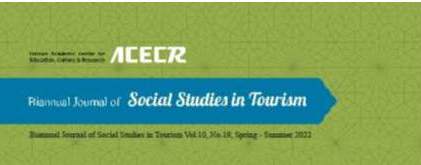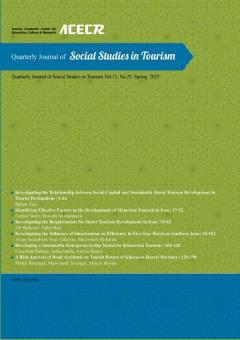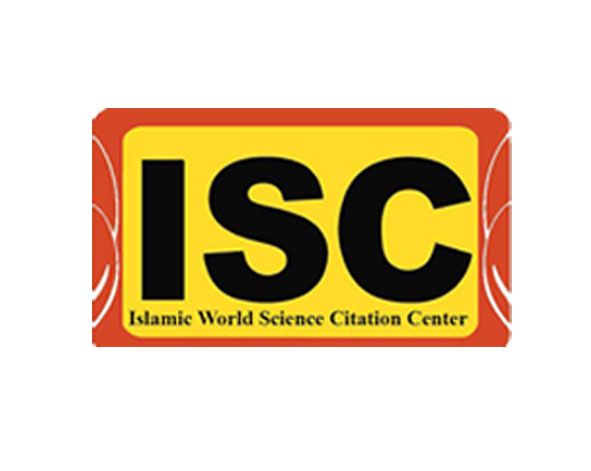About the journal
Recent Articles
-
Open Access Article
1 - The Interaction and Linking of Social Capital and Sustainable Development of Rural Tourism in Touristic Destinations Using the VICE Model
Rahim ZareIssue 29 , Vol. 13 , Spring 2025 -
Open Access Article
2 - Identifying Effective Factors in the Development of Memorial Tourism in Iran
Farhad Javan mostafa mohammadiIssue 29 , Vol. 13 , Spring 2025 -
Open Access Article
3 - Investigating the Requirements for Smart Tourism Development in Iran
Ali Shakoori Zahra RajiIssue 29 , Vol. 13 , Spring 2025 -
Open Access Article
4 - Investigating the Influence of Smartization on Efficiency in Five-Star Hotels in Southern Iran
AZAM SAFARABADI SINA ZAFARIAN masoomeh moharrerIssue 29 , Vol. 13 , Spring 2025 -
Open Access Article
5 - Developing a Sustainable Entrepreneurship Model for Khuzestan Tourism
Faraj Allah Rahimi Asma Salehi Arezoo KiarsiIssue 29 , Vol. 13 , Spring 2025 -
Open Access Article
6 - A Risk Analysis of Road Accidents on Tourist Routes of Khorasan Razavi Province
Masoume Tavangar mahdi bazargan alireza moeiniIssue 29 , Vol. 13 , Spring 2025
Most Viewed Articles
-
Open Access Article
1 - Identifying and Prioritizing Different Aspects of Tourist's Experience Quality from Viewpoints of Foreign Tourists Traveled to Shiraz
mahdi farmani Mohammad ghaffari Navid Shafiei mostafa zandinasabIssue 17 , Vol. 9 , Spring_Summer 2021 -
Open Access Article
2 - Creating a Sustainable Competitive Advantage in the Hotel Sector (The integrated approach of agency theory and Resource Based View)
محمدرضا فرزین mostafa mahmoudi mehdi karoubi akbar pourfarajIssue 14 , Vol. 7 , Autumn_Winter 2019 -
Open Access Article
3 - The Impact of Green Human Resource Management on Environmental Performance of Hotel Employees
Abbas Ali Rastegar Mehdi Sabokro morteza Maleki Minbash Razgah hooshmand bagheri garbollaghIssue 14 , Vol. 7 , Autumn_Winter 2019 -
Open Access Article
4 - Consumer Behavior in E-Tourism Services
sakineh jafari Mohammad najjarzadeh rezvan Golestaneh narjes deyrgandomIssue 10 , Vol. 5 , Autumn_Winter 2017 -
Open Access Article
5 - Evaluating the socio– cultural impact of tourism on the host community (case study: Baneh)
mehdi karoubi ساسان احمدی Mohammad rIssue 8 , Vol. 4 , Autumn_Winter 2016 -
Open Access Article
6 - Identifying Goals of Strategic Alliances Case: Medical Tourism Businesses in Iran
Ali Asghar Shalbafian Hashem Aghazadeh hamid Reza Zargham Broujeni Ali HeidariIssue 12 , Vol. 6 , Autumn_Winter 20172018 -
Open Access Article
7 - Typology of Cultural Tourism Action (Case Study: Mashhad pilgrims and tourists)
Sahar Eghbali Mozhgan Azimi Hashemi Hamed BakhshiIssue 6 , Vol. 3 , Autumn_Winter 2016 -
Open Access Article
8 - Exploring the Relationship between the Culture of Cooperation and the Creative Performance of Tourism Hoteling Organizations Staff
majid sarani ali akbar amin bedokhti sakineh jafariIssue 15 , Vol. 8 , Spring_Summer 2020 -
Open Access Article
9 - The Mediating Role of Travel Motivation and Responsible Behavior with the Relationship between Environmental Attitude and the Sustainable Development of Ecotourism Case: Cities of Mahdishar and Semnan
samaneh parsa سید حسن کابلی sakineh jafariIssue 12 , Vol. 6 , Autumn_Winter 20172018 -
Open Access Article
10 - A Conceptual Model for the Cultural Tourism Sustainable Development: a meta-synthesis approach
Mohanna Nikbin hamid Reza Zargham Broujeni sayed reza salehi amiri kamran mohamadkhani farhad ghaffariIssue 14 , Vol. 7 , Autumn_Winter 2019





